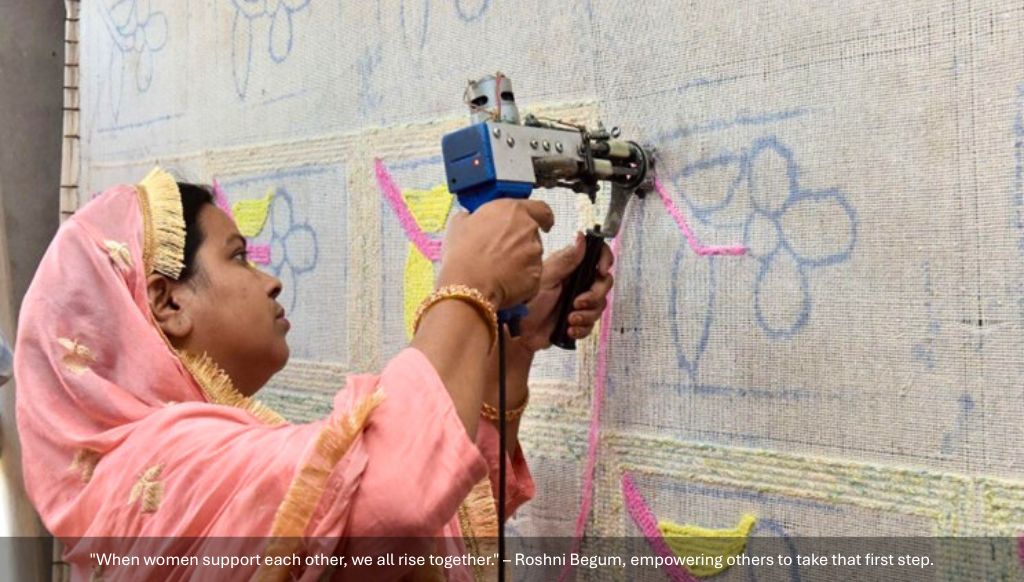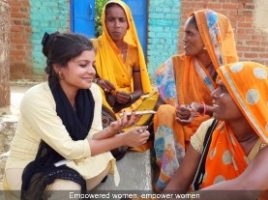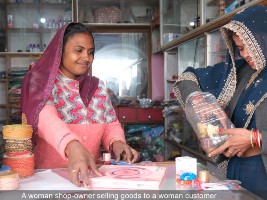Finance that Builds Futures: Reimagining Capital to Unleash Inclusive Entrepreneurship

The global financial landscape is undergoing a significant transformation, marked by heightened volatility and rapidly changing credit dynamics. In India, these global shifts are mirrored by domestic challenges which underscore a critical issue: while traditional financial systems are adapting to new global realities, significant segments of the population face exclusion and continue to struggle with unmet capital needs.
Meanwhile, the microfinance sector, with a growing portfolio in excess of ₹4 lakh crore , tries to serve the underserved without the innovation or flexibility required. Non-performing assets (NPAs) have surged to ₹50,000 crore as of last year , revealing a system that no longer meets evolving needs and changing aspirations.
The Finance Gap: Women Underserved
While women’s participation in entrepreneurship is rising, business loans account for a mere 3% of all loans taken by women in 2024 – far behind personal and gold loans. Between the ₹10,000 to ₹50,000 loans within Self-Help Groups and the above ₹10 lakh ticket sizes of enterprises funded by various financial institutions, lies a wide chasm.
Banks rely on standardised risk assessments that often fail to capture the true potential of an entrepreneur – penalising women for lower educational qualifications, lack of prior business experience, or the absence of a male co-applicant. These rigid perceptions increase loan rejection rates, especially for women in rural areas.
According to TransUnion CIBIL Insights women actually have better credit profiles and repayment rates than men. In Development Alternatives’ (DA’s) work in women’s economic empowerment, we’ve consistently seen that women entrepreneurs not only repay their loans on time but often go on to expand their businesses, hire others, and support their communities. Still, they face enormous barriers to scale, especially when they’re ready to move beyond microloans. Even when finance does reach women, it typically recirculates within the same closed networks where borrowers get repeat loans. Between 2016 and 2021, the number of ‘New to Credit’ (NTC) women borrowers grew from 8.1 million to 9.6 million – just a 3% annual increase. This slow growth underscores how existing systems continue to exclude millions of credit-deserving women from accessing formal finance.
The Missing Middle: When Aspiration Meets a Dead End
Let’s stop calling rural India “resource-poor.” It’s rich in people, networks, and institutions. SHGs, FPOs, and CLFs are no longer just savings groups. Rural women entrepreneurs are stepping far beyond traditional roles like managing vehicle repair centers, running construction work, optical stores and Shakti Kendras. Shakti Kendra was set up by Development Alternatives as a model to showcase how women collectives with more agency on local resources can ensure green and inclusive growth. It is a high-growth manufacturing unit in which multiple businesses are run by women. These manufacturing enterprises are powered by 10-15 kW solar power and have an annual revenue of Rs 3-4 lakh. These kendras include production units such as oil expeller unit, chappal (slipper) manufacturing, groundnut thrasher unit, pelletisation unit, etc. In Badagaon, Jhansi, the Shakti Kendra run by the Shri Rajaram Sarkar Sankul Samiti is led by Parvati, Kalpana, and Munni – women who aren’t just managing a solar-powered enterprise, but reimagining what rural industry can look like.
Most of the businesses in rural India are too small for banks and often too “non-traditional” for any mainstream lender to bet on. The result? Dreams stall. Momentum breaks. Potential remains untapped.
But with timely, dignified finance, women don’t just survive – they multiply impact.
Like many women entrepreneurs, Roshni Begum, a doormat producer from Mirzapur, faced a cash flow crunch as the capital cycle worked against her. Her business did not lack demand, but to keep her production going, she needed to pay upfront for raw materials, wages, and logistics, often waiting weeks for payments from buyers. She bore all the risks and yet remained the last to be paid. Roshni’s turning point came when she gained access to a ₹25,000 loan from an MFI. It wasn’t a large amount by institutional standards, but for her, it meant continuity, confidence, and control. Roshni now employs 20 more women, she is what we call a “serial entrepreneur”, facilitating economic independence for more women in her community where she also helps other women get loans.
“When I got the chance to employ more women, it gave me more than just visibility -it boosted my confidence. I also participated in peer-to-peer sessions where I shared my learnings and struggles with other women entrepreneurs. Now, I want to help more women like me take that first step. If we support each other, we all rise together.” – Roshni Begum
Moving Beyond the Financial Instruments of the Past
Many of our current systems were never designed for rural women or women in general. Credit scores like CIBIL are built on assumptions of salaried income, property ownership, and formal transactions. What about women who run household-based businesses? Who borrow informally, but repay religiously?
In rural contexts, credit dignity and financial fluidity matter more than credit scores. To truly empower women, finance must be redesigned around three pillars: Time – aligned with seasonal incomes and daily rhythms; Trust – built on SHGs, peer networks, and community leaders; and Terrain – adapted to digital gaps, weak infrastructure, and gendered barriers. Only credit systems rooted in real-world realities can unlock true financial inclusion.
To move beyond traditional credit assessment models that often exclude first-time or informal entrepreneurs, Development Alternatives has adopted AI-driven credit underwriting in partnership with Rang De, India’s pioneering peer-to-peer lending platform. Unlike conventional CIBIL, this approach builds a more contextual, demographic-centric credit profile, reflecting ground realities like income cycles, repayment behavior, and social trust. Over 15,000 entrepreneurs, many of them first-time borrowers without any prior credit history, have already accessed this service, unlocking pathways to formal loans. This isn’t just an innovation in scoring – it’s a shift in who gets to be seen as “creditworthy.”
Fueling a Million Aspirations in 1000 Days
In our mission to cater to a million livelihoods, Development Alternatives and our partners are reimagining finance as a tool for agency, aspiration, and acceleration. We are laying the foundation for a future where money moves with purpose and livelihoods multiply at scale.
Our approach is simple but bold:
- Aspire: Begin with the ambitions of the people.
- Embed: Build inside existing systems, not outside them.
- Catalyse: Use finance to unlock ecosystems – not just disburse capital.
It’s time for community-based credit ratings, peer endorsements, transaction-based assessments, and micro-equity models. We need to reward behaviours like timely repayment, risk-sharing through collectives, or climate-positive practices. We must move away from the “one-size-fits-all” model toward persona-based financing, recognising the diverse journeys of entrepreneurs as youth, mothers, migrants, or micro-innovators.
To respond to this shift, DA promoted social impact venture – Indian Micro Enterprise Development Foundation is also building a Credit Guarantee Fund (CGF) in partnership with Givfunds to bridge the persistent financing gap faced by “missing middle” entrepreneurs – those who are too big for microfinance but too small or informal for banks. The fund is being designed to replace debt-heavy instruments and blend donor, lender, and community capital to de-risk lending, expand access, and enable dignified finance for first-time borrowers who are often deemed “new to credit.” The CGF will propel the lending institutions to extend credit to underserved entrepreneurs by covering initial losses and incentivizing them.
As we develop this new financial architecture, innovative products are also being crafted to align with the lived realities of women and rural entrepreneurs – flexible, contextual, and rooted in trust, not just credit scores. Together, these shifts signal a move toward a more inclusive, responsive financial system.
India is changing. Rural India is not just watching this change – it is driving it. Let’s not ask how we can give them finance. Let’s ask: how can finance evolve to deserve entrepreneurs like Roshni, Parvati, Kalpana and Munni?
The views expressed in the article are those of the authors and not necessarily those of Development Alternatives.
This blog first appeared as an editorial in Development Alternatives Newsletter April 2025 https://devalt.org/newsletter/77-celebrating-national-technology-day
[1] IMF says financial stability risks increased significantly amid trade turmoil
[2] World Bank – Financial Inclusion Evaluation
[3] MFI portfolio touches Rs 4 lakh crore across India – The Economic Times
[4] IndusInd issue puts the spotlight on India’s banking sector – The Economic Times
[5] From Borrowers to Builders Women’s role in India’s financial growth story
[5] TransUnion CIBIL Insights Show That Women Exhibit Better Credit Profiles






Leave a Reply